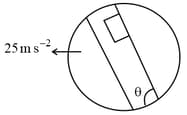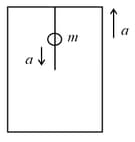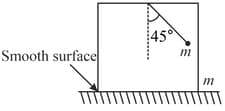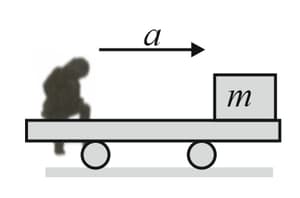Non-inertial Frame and Pseudo Force
Non-inertial Frame and Pseudo Force: Overview
This topic covers concepts such as Pseudo Force, Motion in Accelerating Frame, Pseudo Force in Linearly Accelerated Frames, and Limitations of Newton's Laws of Motion.
Important Questions on Non-inertial Frame and Pseudo Force
A circular disc with a groove along its diameter is placed horizontally on a rough surface. A block of mass is placed as shown. The co-efficient of friction between the block and all surfaces of groove and horizontal surface in contact is The disc has an acceleration of towards left. Find the acceleration of the block with respect to disc. Given,

Two blocks of mass and , connected to each other by a massless inextensible string of length are placed along a diameter of a turn table. The coefficient of friction between the table and is while there is no friction between and the table. The table is rotating with an angular velocity of about a vertical axis passing through its centre . The masses are placed along the diameter of the table on either side of the centre such that the mass is at a distance of from . The masses are observed to be at rest with respect to an observer on the turn table. Calculate the frictional force on .
A block is kept on a frictionless inclined surface with angle of inclination . The incline is given an acceleration to keep the block stationary. Then is equal to –

A spring balance is attached to the ceiling of a lift. A man hangs his bag on the spring and the spring reads , when the lift is stationary. If the lift moves downward with an acceleration of , the reading of the spring balance will be –
What was the limitations of Newton's law
Newton’s first law of motion is not valid for______
Newton's laws of motion cannot be applicable to the particle moving at a speed comparable to the speed of
Are there limitations to Newton’s third law? Why?
A piece of wire is bent in the shape of a parabola (-axis vertical) with a bead of mass on it. The bead can slide on the wire without friction. It stays at lowest point of the parabola when the wire is at rest. The wire is now accelerated parallel to the -axis with a constant acceleration . The distance of the new equilibrium position of the bead, where the bead can stay at rest with respect to the wire, from the -axis is
A boy is in a lift which is moving downwards with an acceleration . At an instant when the velocity of the lift is , then boy throws a ball upwards with a velocity . The time in after which the ball will return into the hand of boy is

A girl drops an apple from the window of a train which is moving on a straight track with speed increasing with a constant rate. The trajectory of the falling apple as seen by the girl is
A cabin is moving vertically upwards with an acceleration A massless string is attached to the ceiling of the cabin on which a bead of mass is sliding downwards with respect to string with an acceleration The tension in the string is

A rocket is going upwards with accelerated motion. A man sitting in it feels his weight increased times his own weight. If the mass of the rocket including that of the man is . The force applied by rocket engine is .
A ball connected with string is released at an angle with the vertical as shown in the figure. Then the acceleration of the box at this instant will be (mass of the box is equal to mass of ball)

In the figure, the wedge is pushed with an acceleration of . It is seen that the block starts climbing up on the smooth inclined face of wedge. What will be the time taken by the block to reach the top?
A car is moving on a plane inclined at
Suppose you are sitting on an accelerating trolley car.

Find the pseudo force acting on the block as viewed by the observer.
Suppose you are sitting on an accelerating trolley car.

Find the acceleration of the block as seen by the observer.
A bead of mass $m$ is fitted on a rod and can move on it without friction. Initially the bead is at the middle of the rod. What will be the acceleration of bead with respect to rod is if the rod moves translationally in a horizontal plane with an acceleration in horizontal direction forming angle with the rod.
With what acceleration should the table be moved so that the 10 kg block remains at rest relative to the table?


